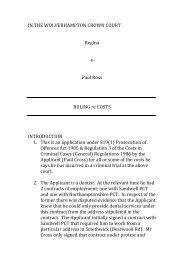You also want an ePaper? Increase the reach of your titles
YUMPU automatically turns print PDFs into web optimized ePapers that Google loves.
however, are the jury to be directed that they can infer that intention if D2
foresaw that D1 would act with the requisite intention, so long as D2’s foresight
of that was more than de minimis?
Alternatively, should the jury be directed that they are only entitled to infer the
requisite intent if D2 foresaw that D1 would act with intent to kill or cause really
serious injury as a virtually certain consequence of D2’s act of encouragement,
even if D2 did not appreciate that death or really serious injury was a virtually
certain consequence of the act of D1 that he encouraged?
The issue becomes striking if the Crown cannot establish the identity of the
principal. Ormerod poses the question, in those circumstances is the judge
required to direct the jury - in relation to each defendant - that there are two
different routes to finding intention, depending upon whether they are principal
or accessory?
The Supreme Court failed to specify whether the jury is only entitled to infer the
necessary intention if they are sure that D2 possessed a high level of foresight. It
is unclear whether it is safe to conclude from this omission that the Supreme
Court did not intend for some version of the Woollin direction to apply.
Of course, in most cases, the prosecution will continue to allege that D2 intended
D1 to do the relevant acts and in fact intended D1 to commit the crime. The real
risk is that prosecutors if needed will argue that foresight of a possibility of what
D1 might do, however slim a possibility, is enough to show a conditional
intention to assist or encourage D1, or indeed, a conditional intention that D1
commit the crime.
Problem with Cogan & Leak?
Requiring an intention on the part of the aider/abettor which focuses, in turn, on
the state of mind of the principal may also prove a problem to the principle set
out in Cogan & Leak (1975) 61 Cr App R 217.
14










